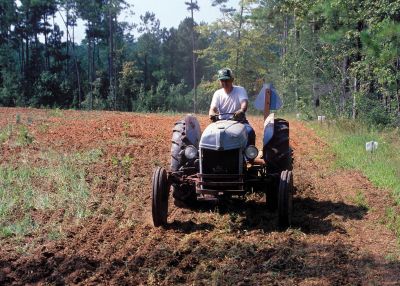White-tailed deer require high quality foods for optimal growth. Research has found that a whitetail are selective browsers and that a diet of at least 16 percent protein is required. Of course, better nutrition equates to better fawn production, improved antler growth and a healthier deer herd. One of the most common deer management techniques used to achieve these objectives is through the planting of food plots. Many hunters understand why food plots work, but not all understand how to plant a food plot for whitetail deer. Although establishing food plots is not easy, it is not difficult either. A little knowledge, prep work and some time in the field will get the job done.
The first step is to site the food plot. Where will it go? Look for areas that provide the best soils and that require very little clearing. You can get some great information about your soils from the USDA’s Web Soil Survey. If nothing is available, then tree or brush removal will be required. Also, look for areas that are relatively flat. You do not want erosion to wash away all of your freshly disturbed soil. After a site for your deer food plot is selected, the next step is a soil test.

Soil samples should be taken from each area to be planted and sent to a soil testing lab for analysis. A soil test determines how much lime and fertilizer is needed to grow a specific plant species to its maximum potential. Soil tests should be conducted at least every two years for each food plot site. Believe it or not, tremendous amounts of nutrients are removed from the soil each year by the growing plants. In addition, many nutrients are lost by leaching due to rain. Taking a soil sample is an easy task. The only materials needed are a shovel or soil probe, a clean bucket, and boxes or bags to ship the samples.
Next, pay attention to what the soil test. It will not help your food plot if you get the soil test, but ignore the results. To get the most production from your plot, it is very important to follow the lime and fertilizer recommendations exactly. Of the two, the most benefit is gained from adding the recommended amount of lime to raise the soil pH to the recommended level. Having the soil pH in the optimum 6.5 to 7.0 range enables plants to utilize a much larger percentage of the available soil nutrients than when the soil pH is too acidic or too basic.
In addition, ensure that you apply lime well in advance of planting a food plot for whitetail deer or other wildlife. Apply the lime three to six months ahead of time to give the lime adequate time to do its job. Lime is commonly applied in the form of limestone, so do not be surprised if several thousand pounds per acre are required to correct soil pH. Lime is relatively inexpensive, so a little money buys a lot.
The next step in planting a food plot is preparation of the seedbed. Preparing a firm, smooth seed bed is essential for a good food plot. A good seed bed improves seed to soil contact, improves seed germination, and leads to better plant establishment. This all results in better forage production and a better food plot for your deer. A better food plot means healthier whitetail deer. Mowing or bush-hogging existing vegetation just before to plowing is the most common way to remove existing plant material.
The biggest problem with mowing just before planting is the cut vegetation makes it hard to get good soil disturbance with most equipment used for food plot establishment by landowners. Mowing vegetation at least two weeks ahead of disking or tilling is highly recommended. Another option is to spray the existing vegetation with a glyphosate herbicide such as Roundup. Spray existing vegetation about three weeks before breaking ground. Plowing, disking or tilling the top four to six inches of soil is sufficient for most winter food plots since they tend to be shallow-rooted.
Turn the soil over well until the soil is evenly broken-up and the seedbed looks relatively smooth. Seeds can then be broadcasts at the appropriate rate and at the appropriate time. Next, roll the food plot with a packer or culti-packer to get a good seed-soil contact. Another option would be to spray and shred the area in advance, but then use a seed drill to drill seeds into the soil. Most people will not have access to a seed drill, but if you do, use it.
To wrap up, food plots do a great job at supplementing the diets of white-tailed deer. However, time and money will be wasted if the food plot is not developed and planted properly. The steps outlined above are how we plant food plots for whitetail deer on an annual basis. From experience, I can tell you that shortcuts sound quite tempting when plots are being developed, but you will regret it when the plot does not work. Take your time, do it right and help the deer in your area.
Where do you buy your lime, fertilizer, and seed?